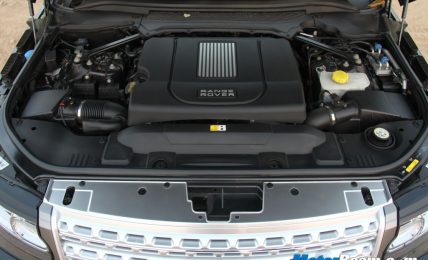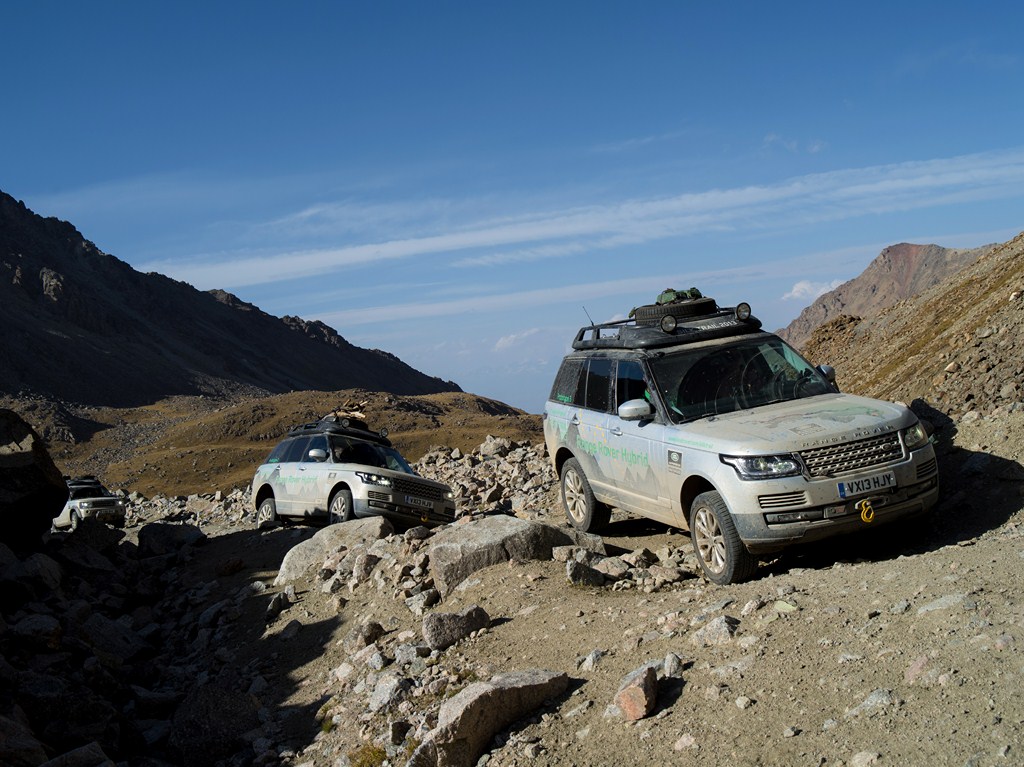The diesel engine is extremely refined but has some amount of turbo lag
Performance – Before you even think of mashing the throttle, you have to get used to the massive dimensions of the Range Rover LWB. This SUV is available with 4 engine options in India, 2 each for petrol and diesel, our test car is powered by a 3.0-litre diesel V6 which outputs 255 HP and 600 Nm. Refinement levels are stellar, there is no way you will be able to tell that this is indeed a diesel engine, such is the level of NVH. As you rev it, the powerplant does sound sporty in the mid-range where the nose lifts a bit too. There is a Dynamic mode which tightens the suspension, holds onto gears longer and increases the heft on the steering wheel.
The automatic transmission is slow to shift but very smooth
One can equip the Range Rover with a Supercharged V8 petrol engine should they desire more performance
The oil burner accelerates smoothly but there is low-end lag and a kick in the pants feel when the turbo kicks in, pulling the Range Rover with urgency, albeit the punch is a fist blow but doesn’t last long since the motor revs quickly and redlines under 4500 RPM, the 8-speed gearbox upshifting at just 4000 RPM for the most part. The transmission could have offered faster shifts, more so in S mode but it’s really the smoothness that shines here. You can manually change cogs using the steering mounted paddles but it won’t hold onto a gear and will upshift as it reaches the redline. The fuel tank capacity is around 85-litres and the fuel efficiency is between 5 to 8 km/l.
This SUV is engineered for carrying its passengers in utmost comfort
The Range Rover 3.0-litre diesel takes 8 seconds to go from 0 to 100 km/hr with a top speed of 209 km/hr. Want more performance? For an additional Rs. 30 lakhs, you can get the more powerful V8 diesel, the 4.4-litre powertrain offers 80 more horses at 355 HP and 740 Nm of torque but also weighs 200 kgs more. The result is a faster time to the ton by just half a second while the top speed increase is 8 km/hr. If you really want performance, the 5.0-litre Supercharged petrol V8 does 5.5 seconds to the ton and also has a 105-litre fuel tank to counter the 3 km/l mileage. Now you might wonder why Range Rovers are so gas guzzling and can you not get an efficient model? Although not in India but globally there is also a diesel-hybrid which will definitely be more popular here.
The ride quality of the flagship Land Rover is truly unparalleled
Driving Dynamics – The current generation Range Rover uses an aluminium monocoque (D7u) with aircraft level riveting for the construction. The suspension is on the softer side and the ride quality is just phenomenal. It simply floats on the roads and wafts along, giving a commanding driving position with the air suspension having quite a range of ride height variance (ground clearance can vary from 220 mm to 310 mm). In fact, off-road, the suspension travel is as much as 250 mm at the front and 300 mm at the rear. The brakes offer superb stopping power with nose dive well contained under heavy braking.
The brakes have good stopping power to stop this 2.4 tonne SUV
Apart from the body roll, the driving position and the response from the steering is extremely impressive
The Range Rover is a heavy car, this model tips the scales at 2400 kgs but you can’t feel all that weight as the steering is light at low speeds and weighs up quite well at high speeds, it’s just too responsive in the centre. Expectedly, there is a lot of roll around corners and this isn’t a vehicle to push around the twisties. The V8 models also get active lean software (Dynamic Response in Land Rover speak) while a host of technologies like active rear locking differential ensure optimum grip and Adaptive Dynamics monitors vehicle movement up to 500 times a second to reduce body movements. However, it’s far from being a dynamic SUV but the feel is just something else as you are the king of the road when driving the Range Rover, it makes all other cars look sub-4-metre.



